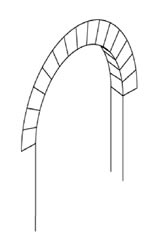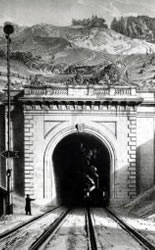Arches
The arch shape is very strong and arches have been used in bridge design for thousands of years.
Building materials such as stone and steel, are very strong when the forces acting on them are compressing them. They are less strong when a single piece is used to span a large gap. The force pushing down on the middle causes both ends to bend and weaken.

By using an arch, the force in the middle is distributed down the sides through the strong pillars.
Stone arches are constructed by first building the pillars either side of the arch and then a wooden structure in the shape you want the arch to be. The curved stones are then laid out and secured over the top of the wooden structure until the last, middle stone (the key stone) is put in place. Once the last stone is in place, the arch will stand on its own and the wooden template can be taken away.

Building Box Tunnel
Box Tunnel, named after Box Hill which it tunnels through, was begun in 1836 and completed in 1841.
It was a huge task to blast and dig through nearly 3km (2 miles) of hard rock. They used a tonne of gunpowder and a tonne of candles every week!

1500 railway workers (known as ‘navvies’) worked on the tunnel, one team working through the day and the other team working through the night. They shared beds, the two teams didn’t need them at the same time!
It is said that Brunel, who often worked for 18 hours a day, would roll his sleeves up and help the navvies dig when he went to check their progress. Tunnel building was a very dangerous job in Victorian times and 100 navvies died during the tunnel’s construction.
The tunnel is completely straight and it is claimed that Brunel designed it so that on his birthday, 9th April, the sun would shine right through it. However, this has never been proven.
The workers dug from both the East and West sides of the tunnel at the same time and Brunel’s calculations were so accurate that when the two teams met in the middle they were only 5cm apart.
Whilst building the tunnel, Brunel uncovered large amounts of Bath Stone which was (and still is) very popular as a building material. As a result, Box Quarry opened up next to the tunnel and vast caverns of stone were mined out of the hill.
Once Brunel completed the tunnel he knew that he would have to persuade Victorians - who weren’t used to travelling on trains, let alone through long, dark tunnels - that they wouldn’t be squashed as the train entered the tunnel.
To overcome these fears, he built the entrances more than twice the height and width of the trains that would be using the tunnel, although the tunnel got much narrower once it was too dark to see.
The tunnel was finally opened on 30th June 1841, although to begin with some passengers refused to travel through it, taking a horse and cart around the hill and meeting the train on the other side! The tunnel is still used today.